Finance and Funding in the Travel and Tourism Sector: AHTC Report
VerifiedAdded on 2020/01/07
|13
|3820
|126
Report
AI Summary
This report provides a comprehensive analysis of finance and funding within the travel and tourism sector, focusing on AHTC. It begins with an introduction to the significance of finance in the industry and then delves into Cost-Volume-Profit (CVP) analysis, exploring its importance in financial management and its application in selecting appropriate pricing strategies. The report describes various pricing methods, including dynamic pricing, markup pricing, last-minute pricing, seasonal pricing, skimming pricing, and discounting strategies, and evaluates factors that influence profit, such as promotion and advertisement, climatic conditions, natural disasters, and terrorist attacks. It also examines different types of management accounting information and assesses the use of investment appraisal techniques. Furthermore, the report includes an interpretation of financial ratios and analyzes various sources of funding available to AHTC. The report concludes with a summary of key findings and includes a table of financial ratios and a list of references.
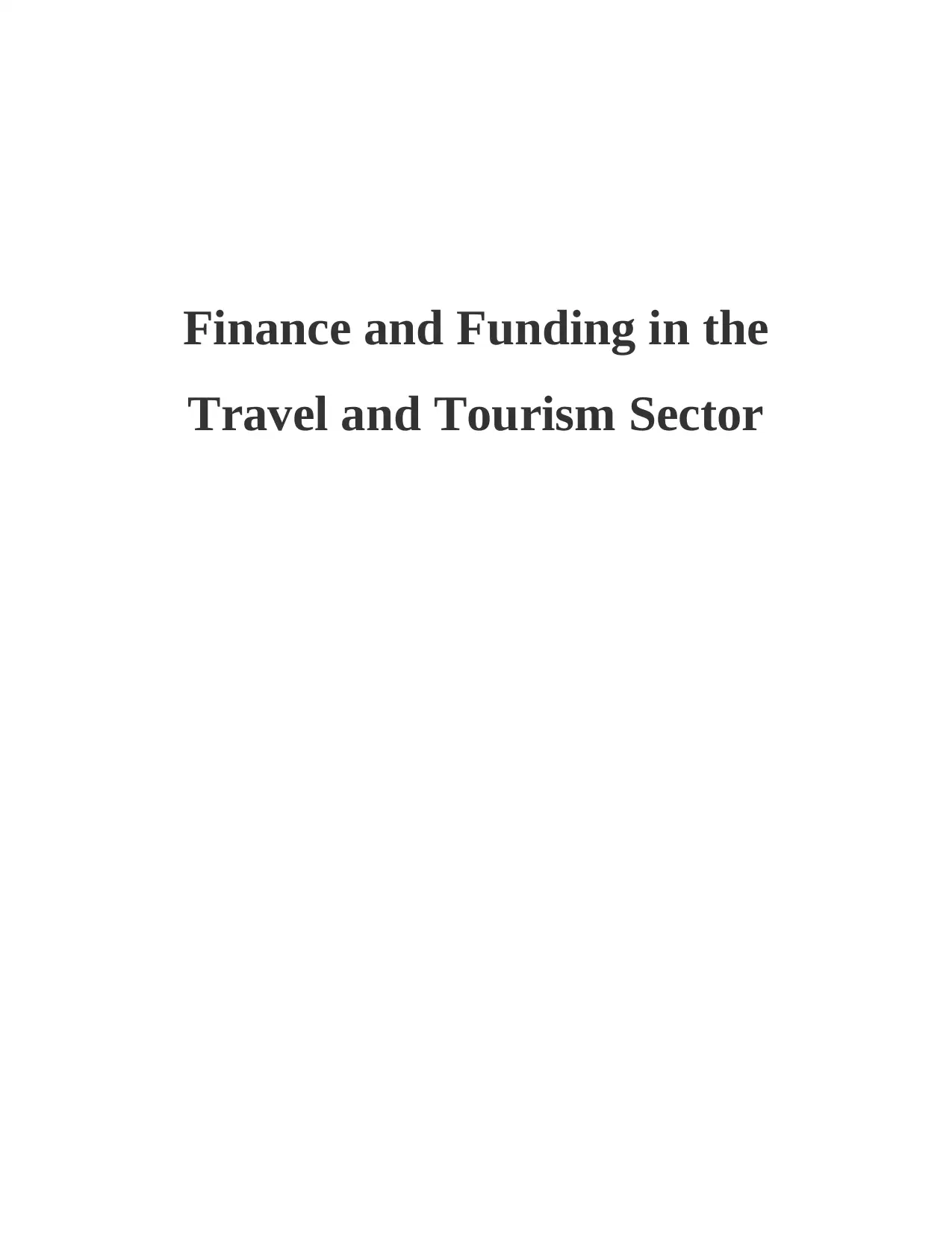
Finance and Funding in the
Travel and Tourism Sector
Travel and Tourism Sector
Paraphrase This Document
Need a fresh take? Get an instant paraphrase of this document with our AI Paraphraser
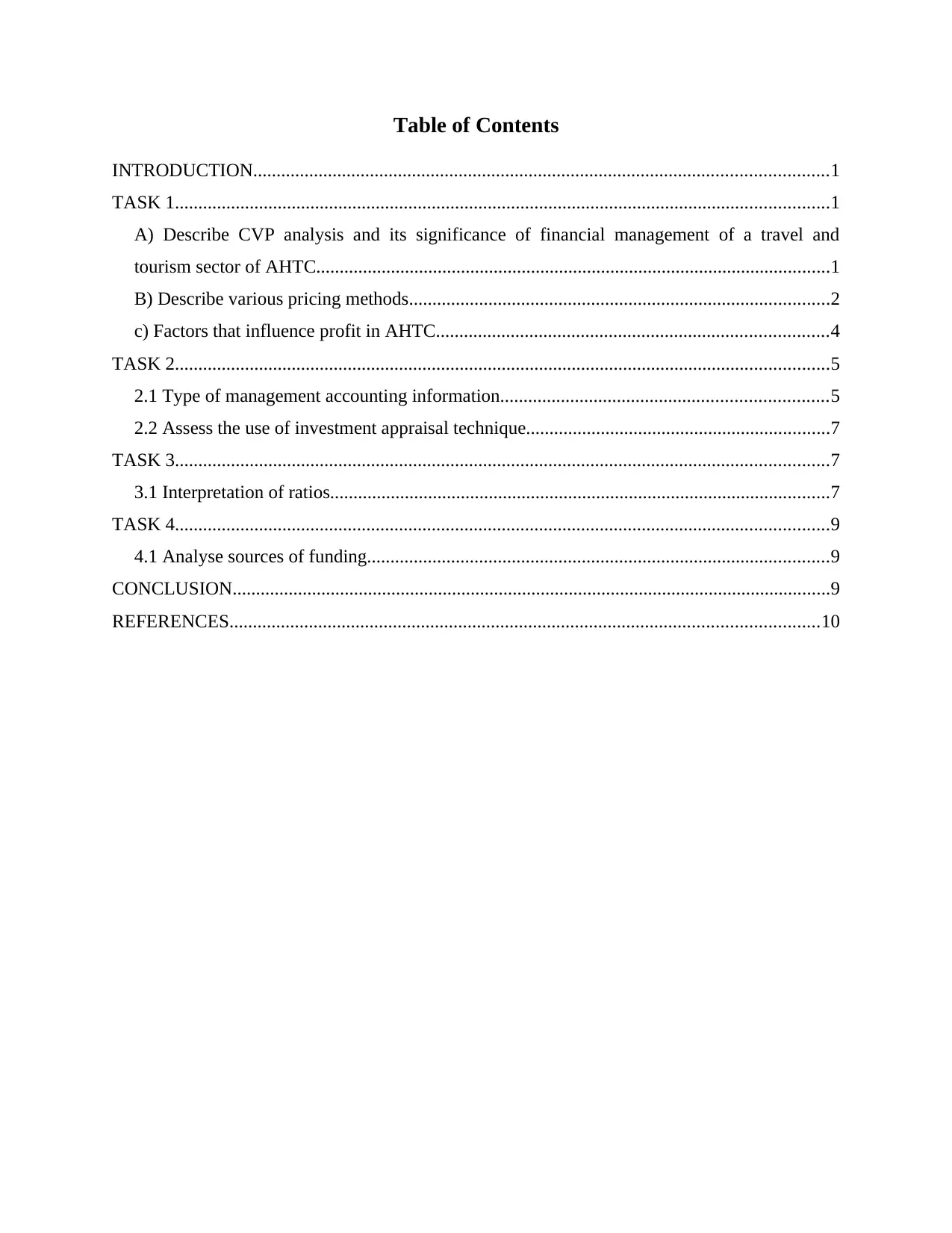
Table of Contents
INTRODUCTION...........................................................................................................................1
TASK 1............................................................................................................................................1
A) Describe CVP analysis and its significance of financial management of a travel and
tourism sector of AHTC..............................................................................................................1
B) Describe various pricing methods..........................................................................................2
c) Factors that influence profit in AHTC....................................................................................4
TASK 2............................................................................................................................................5
2.1 Type of management accounting information......................................................................5
2.2 Assess the use of investment appraisal technique.................................................................7
TASK 3............................................................................................................................................7
3.1 Interpretation of ratios...........................................................................................................7
TASK 4............................................................................................................................................9
4.1 Analyse sources of funding...................................................................................................9
CONCLUSION................................................................................................................................9
REFERENCES..............................................................................................................................10
INTRODUCTION...........................................................................................................................1
TASK 1............................................................................................................................................1
A) Describe CVP analysis and its significance of financial management of a travel and
tourism sector of AHTC..............................................................................................................1
B) Describe various pricing methods..........................................................................................2
c) Factors that influence profit in AHTC....................................................................................4
TASK 2............................................................................................................................................5
2.1 Type of management accounting information......................................................................5
2.2 Assess the use of investment appraisal technique.................................................................7
TASK 3............................................................................................................................................7
3.1 Interpretation of ratios...........................................................................................................7
TASK 4............................................................................................................................................9
4.1 Analyse sources of funding...................................................................................................9
CONCLUSION................................................................................................................................9
REFERENCES..............................................................................................................................10

Index of Tables
Table 1: Ratios of Thomas Cook.....................................................................................................7
Table 1: Ratios of Thomas Cook.....................................................................................................7
⊘ This is a preview!⊘
Do you want full access?
Subscribe today to unlock all pages.

Trusted by 1+ million students worldwide
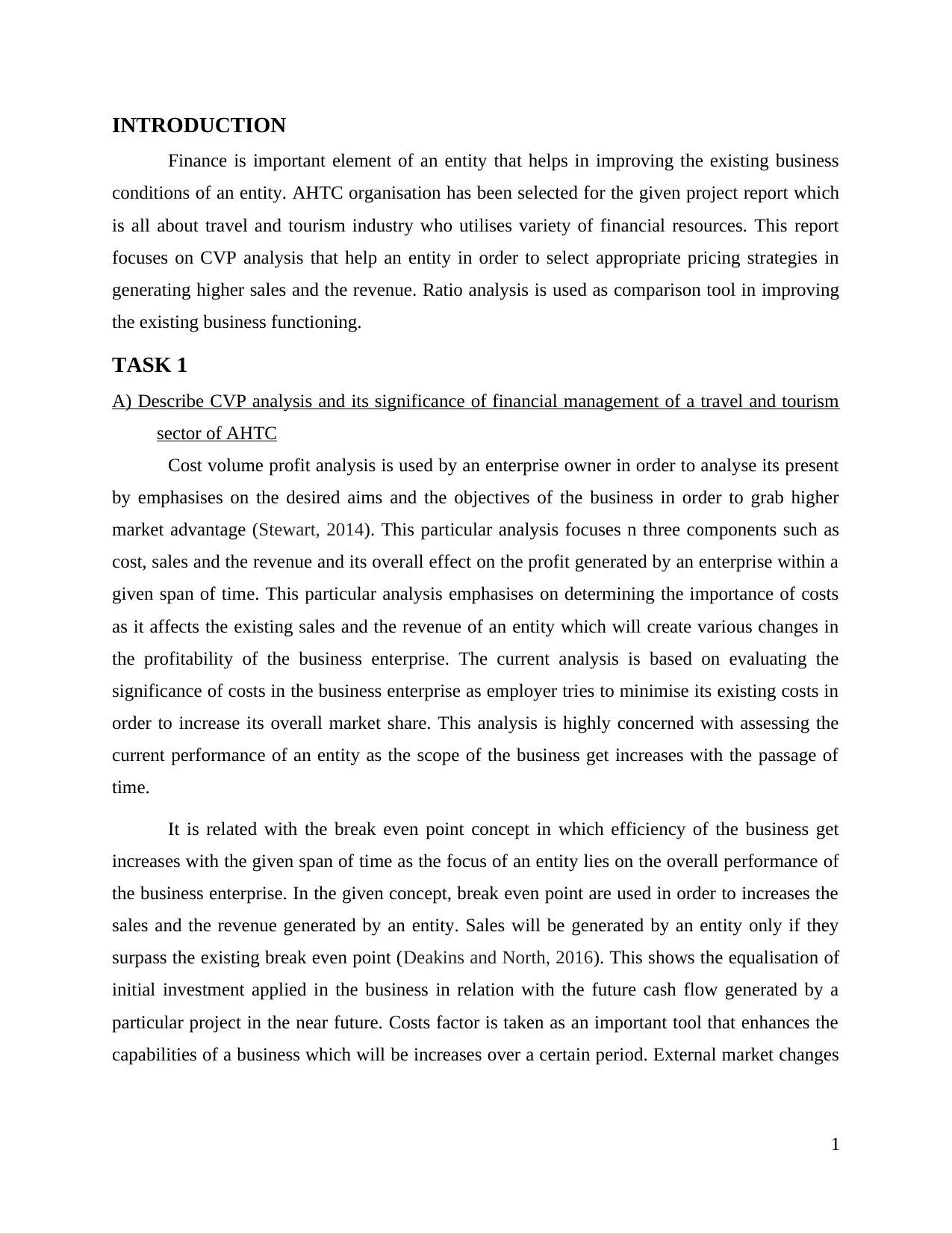
INTRODUCTION
Finance is important element of an entity that helps in improving the existing business
conditions of an entity. AHTC organisation has been selected for the given project report which
is all about travel and tourism industry who utilises variety of financial resources. This report
focuses on CVP analysis that help an entity in order to select appropriate pricing strategies in
generating higher sales and the revenue. Ratio analysis is used as comparison tool in improving
the existing business functioning.
TASK 1
A) Describe CVP analysis and its significance of financial management of a travel and tourism
sector of AHTC
Cost volume profit analysis is used by an enterprise owner in order to analyse its present
by emphasises on the desired aims and the objectives of the business in order to grab higher
market advantage (Stewart, 2014). This particular analysis focuses n three components such as
cost, sales and the revenue and its overall effect on the profit generated by an enterprise within a
given span of time. This particular analysis emphasises on determining the importance of costs
as it affects the existing sales and the revenue of an entity which will create various changes in
the profitability of the business enterprise. The current analysis is based on evaluating the
significance of costs in the business enterprise as employer tries to minimise its existing costs in
order to increase its overall market share. This analysis is highly concerned with assessing the
current performance of an entity as the scope of the business get increases with the passage of
time.
It is related with the break even point concept in which efficiency of the business get
increases with the given span of time as the focus of an entity lies on the overall performance of
the business enterprise. In the given concept, break even point are used in order to increases the
sales and the revenue generated by an entity. Sales will be generated by an entity only if they
surpass the existing break even point (Deakins and North, 2016). This shows the equalisation of
initial investment applied in the business in relation with the future cash flow generated by a
particular project in the near future. Costs factor is taken as an important tool that enhances the
capabilities of a business which will be increases over a certain period. External market changes
1
Finance is important element of an entity that helps in improving the existing business
conditions of an entity. AHTC organisation has been selected for the given project report which
is all about travel and tourism industry who utilises variety of financial resources. This report
focuses on CVP analysis that help an entity in order to select appropriate pricing strategies in
generating higher sales and the revenue. Ratio analysis is used as comparison tool in improving
the existing business functioning.
TASK 1
A) Describe CVP analysis and its significance of financial management of a travel and tourism
sector of AHTC
Cost volume profit analysis is used by an enterprise owner in order to analyse its present
by emphasises on the desired aims and the objectives of the business in order to grab higher
market advantage (Stewart, 2014). This particular analysis focuses n three components such as
cost, sales and the revenue and its overall effect on the profit generated by an enterprise within a
given span of time. This particular analysis emphasises on determining the importance of costs
as it affects the existing sales and the revenue of an entity which will create various changes in
the profitability of the business enterprise. The current analysis is based on evaluating the
significance of costs in the business enterprise as employer tries to minimise its existing costs in
order to increase its overall market share. This analysis is highly concerned with assessing the
current performance of an entity as the scope of the business get increases with the passage of
time.
It is related with the break even point concept in which efficiency of the business get
increases with the given span of time as the focus of an entity lies on the overall performance of
the business enterprise. In the given concept, break even point are used in order to increases the
sales and the revenue generated by an entity. Sales will be generated by an entity only if they
surpass the existing break even point (Deakins and North, 2016). This shows the equalisation of
initial investment applied in the business in relation with the future cash flow generated by a
particular project in the near future. Costs factor is taken as an important tool that enhances the
capabilities of a business which will be increases over a certain period. External market changes
1
Paraphrase This Document
Need a fresh take? Get an instant paraphrase of this document with our AI Paraphraser
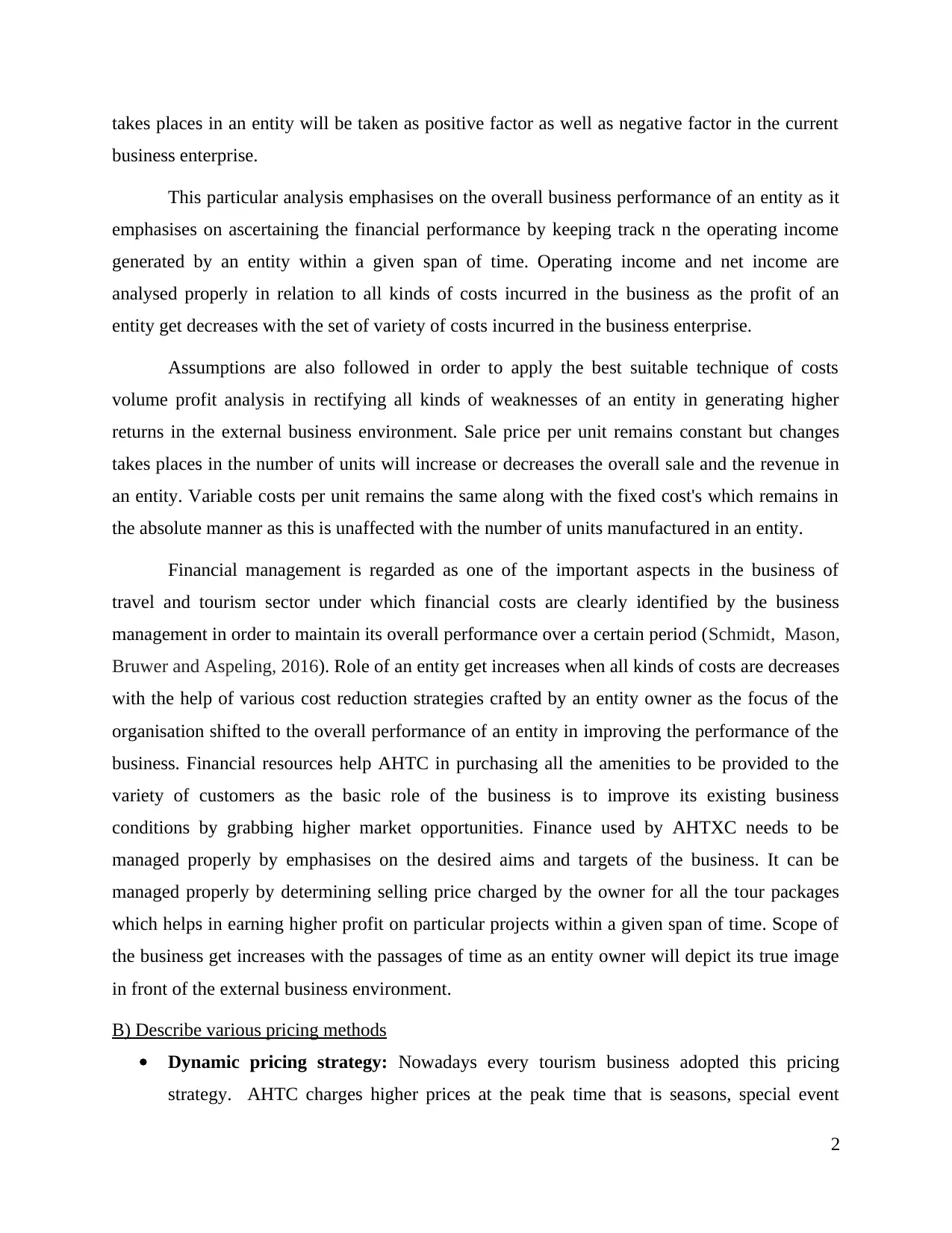
takes places in an entity will be taken as positive factor as well as negative factor in the current
business enterprise.
This particular analysis emphasises on the overall business performance of an entity as it
emphasises on ascertaining the financial performance by keeping track n the operating income
generated by an entity within a given span of time. Operating income and net income are
analysed properly in relation to all kinds of costs incurred in the business as the profit of an
entity get decreases with the set of variety of costs incurred in the business enterprise.
Assumptions are also followed in order to apply the best suitable technique of costs
volume profit analysis in rectifying all kinds of weaknesses of an entity in generating higher
returns in the external business environment. Sale price per unit remains constant but changes
takes places in the number of units will increase or decreases the overall sale and the revenue in
an entity. Variable costs per unit remains the same along with the fixed cost's which remains in
the absolute manner as this is unaffected with the number of units manufactured in an entity.
Financial management is regarded as one of the important aspects in the business of
travel and tourism sector under which financial costs are clearly identified by the business
management in order to maintain its overall performance over a certain period (Schmidt, Mason,
Bruwer and Aspeling, 2016). Role of an entity get increases when all kinds of costs are decreases
with the help of various cost reduction strategies crafted by an entity owner as the focus of the
organisation shifted to the overall performance of an entity in improving the performance of the
business. Financial resources help AHTC in purchasing all the amenities to be provided to the
variety of customers as the basic role of the business is to improve its existing business
conditions by grabbing higher market opportunities. Finance used by AHTXC needs to be
managed properly by emphasises on the desired aims and targets of the business. It can be
managed properly by determining selling price charged by the owner for all the tour packages
which helps in earning higher profit on particular projects within a given span of time. Scope of
the business get increases with the passages of time as an entity owner will depict its true image
in front of the external business environment.
B) Describe various pricing methods
Dynamic pricing strategy: Nowadays every tourism business adopted this pricing
strategy. AHTC charges higher prices at the peak time that is seasons, special event
2
business enterprise.
This particular analysis emphasises on the overall business performance of an entity as it
emphasises on ascertaining the financial performance by keeping track n the operating income
generated by an entity within a given span of time. Operating income and net income are
analysed properly in relation to all kinds of costs incurred in the business as the profit of an
entity get decreases with the set of variety of costs incurred in the business enterprise.
Assumptions are also followed in order to apply the best suitable technique of costs
volume profit analysis in rectifying all kinds of weaknesses of an entity in generating higher
returns in the external business environment. Sale price per unit remains constant but changes
takes places in the number of units will increase or decreases the overall sale and the revenue in
an entity. Variable costs per unit remains the same along with the fixed cost's which remains in
the absolute manner as this is unaffected with the number of units manufactured in an entity.
Financial management is regarded as one of the important aspects in the business of
travel and tourism sector under which financial costs are clearly identified by the business
management in order to maintain its overall performance over a certain period (Schmidt, Mason,
Bruwer and Aspeling, 2016). Role of an entity get increases when all kinds of costs are decreases
with the help of various cost reduction strategies crafted by an entity owner as the focus of the
organisation shifted to the overall performance of an entity in improving the performance of the
business. Financial resources help AHTC in purchasing all the amenities to be provided to the
variety of customers as the basic role of the business is to improve its existing business
conditions by grabbing higher market opportunities. Finance used by AHTXC needs to be
managed properly by emphasises on the desired aims and targets of the business. It can be
managed properly by determining selling price charged by the owner for all the tour packages
which helps in earning higher profit on particular projects within a given span of time. Scope of
the business get increases with the passages of time as an entity owner will depict its true image
in front of the external business environment.
B) Describe various pricing methods
Dynamic pricing strategy: Nowadays every tourism business adopted this pricing
strategy. AHTC charges higher prices at the peak time that is seasons, special event
2
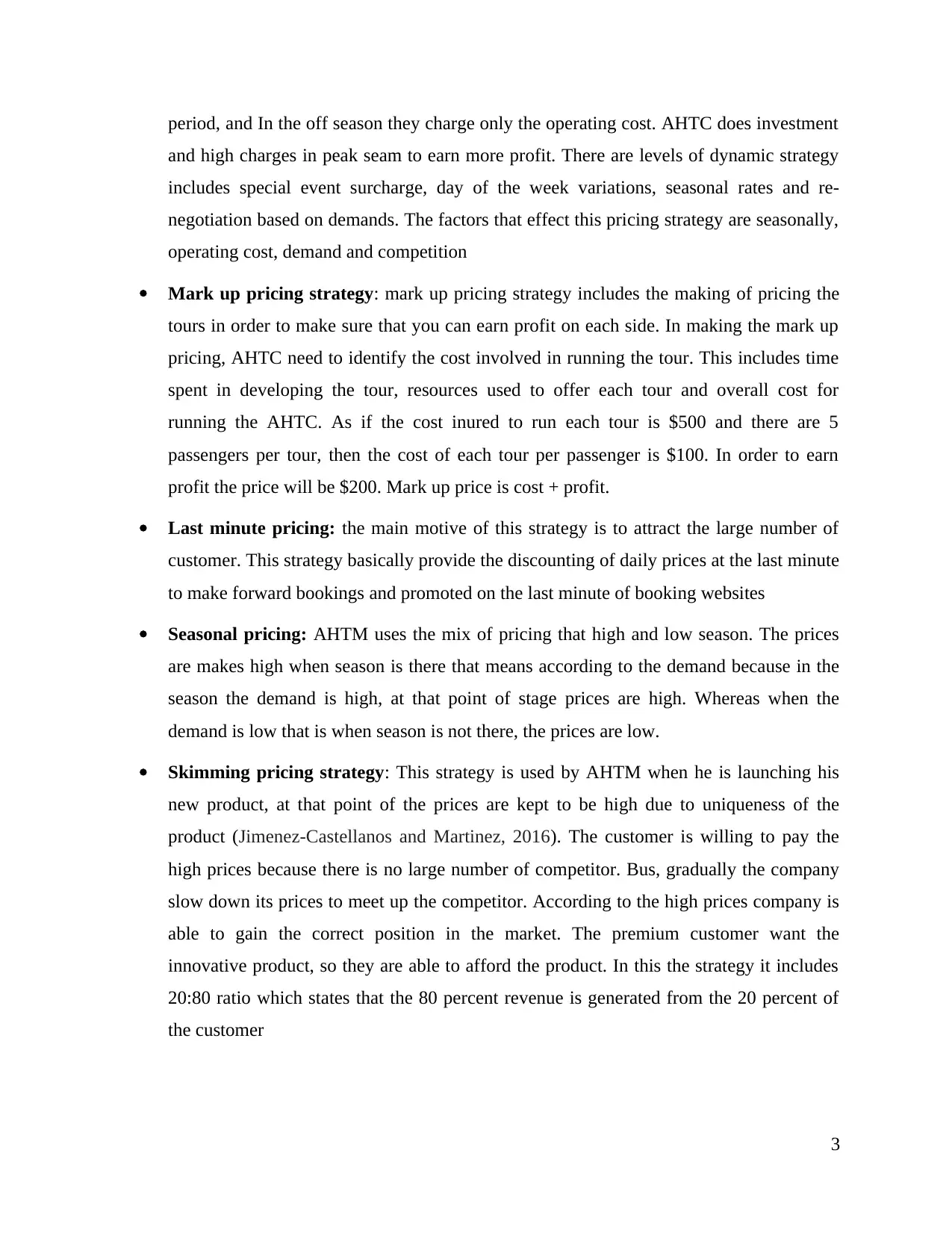
period, and In the off season they charge only the operating cost. AHTC does investment
and high charges in peak seam to earn more profit. There are levels of dynamic strategy
includes special event surcharge, day of the week variations, seasonal rates and re-
negotiation based on demands. The factors that effect this pricing strategy are seasonally,
operating cost, demand and competition
Mark up pricing strategy: mark up pricing strategy includes the making of pricing the
tours in order to make sure that you can earn profit on each side. In making the mark up
pricing, AHTC need to identify the cost involved in running the tour. This includes time
spent in developing the tour, resources used to offer each tour and overall cost for
running the AHTC. As if the cost inured to run each tour is $500 and there are 5
passengers per tour, then the cost of each tour per passenger is $100. In order to earn
profit the price will be $200. Mark up price is cost + profit.
Last minute pricing: the main motive of this strategy is to attract the large number of
customer. This strategy basically provide the discounting of daily prices at the last minute
to make forward bookings and promoted on the last minute of booking websites
Seasonal pricing: AHTM uses the mix of pricing that high and low season. The prices
are makes high when season is there that means according to the demand because in the
season the demand is high, at that point of stage prices are high. Whereas when the
demand is low that is when season is not there, the prices are low.
Skimming pricing strategy: This strategy is used by AHTM when he is launching his
new product, at that point of the prices are kept to be high due to uniqueness of the
product (Jimenez-Castellanos and Martinez, 2016). The customer is willing to pay the
high prices because there is no large number of competitor. Bus, gradually the company
slow down its prices to meet up the competitor. According to the high prices company is
able to gain the correct position in the market. The premium customer want the
innovative product, so they are able to afford the product. In this the strategy it includes
20:80 ratio which states that the 80 percent revenue is generated from the 20 percent of
the customer
3
and high charges in peak seam to earn more profit. There are levels of dynamic strategy
includes special event surcharge, day of the week variations, seasonal rates and re-
negotiation based on demands. The factors that effect this pricing strategy are seasonally,
operating cost, demand and competition
Mark up pricing strategy: mark up pricing strategy includes the making of pricing the
tours in order to make sure that you can earn profit on each side. In making the mark up
pricing, AHTC need to identify the cost involved in running the tour. This includes time
spent in developing the tour, resources used to offer each tour and overall cost for
running the AHTC. As if the cost inured to run each tour is $500 and there are 5
passengers per tour, then the cost of each tour per passenger is $100. In order to earn
profit the price will be $200. Mark up price is cost + profit.
Last minute pricing: the main motive of this strategy is to attract the large number of
customer. This strategy basically provide the discounting of daily prices at the last minute
to make forward bookings and promoted on the last minute of booking websites
Seasonal pricing: AHTM uses the mix of pricing that high and low season. The prices
are makes high when season is there that means according to the demand because in the
season the demand is high, at that point of stage prices are high. Whereas when the
demand is low that is when season is not there, the prices are low.
Skimming pricing strategy: This strategy is used by AHTM when he is launching his
new product, at that point of the prices are kept to be high due to uniqueness of the
product (Jimenez-Castellanos and Martinez, 2016). The customer is willing to pay the
high prices because there is no large number of competitor. Bus, gradually the company
slow down its prices to meet up the competitor. According to the high prices company is
able to gain the correct position in the market. The premium customer want the
innovative product, so they are able to afford the product. In this the strategy it includes
20:80 ratio which states that the 80 percent revenue is generated from the 20 percent of
the customer
3
⊘ This is a preview!⊘
Do you want full access?
Subscribe today to unlock all pages.

Trusted by 1+ million students worldwide
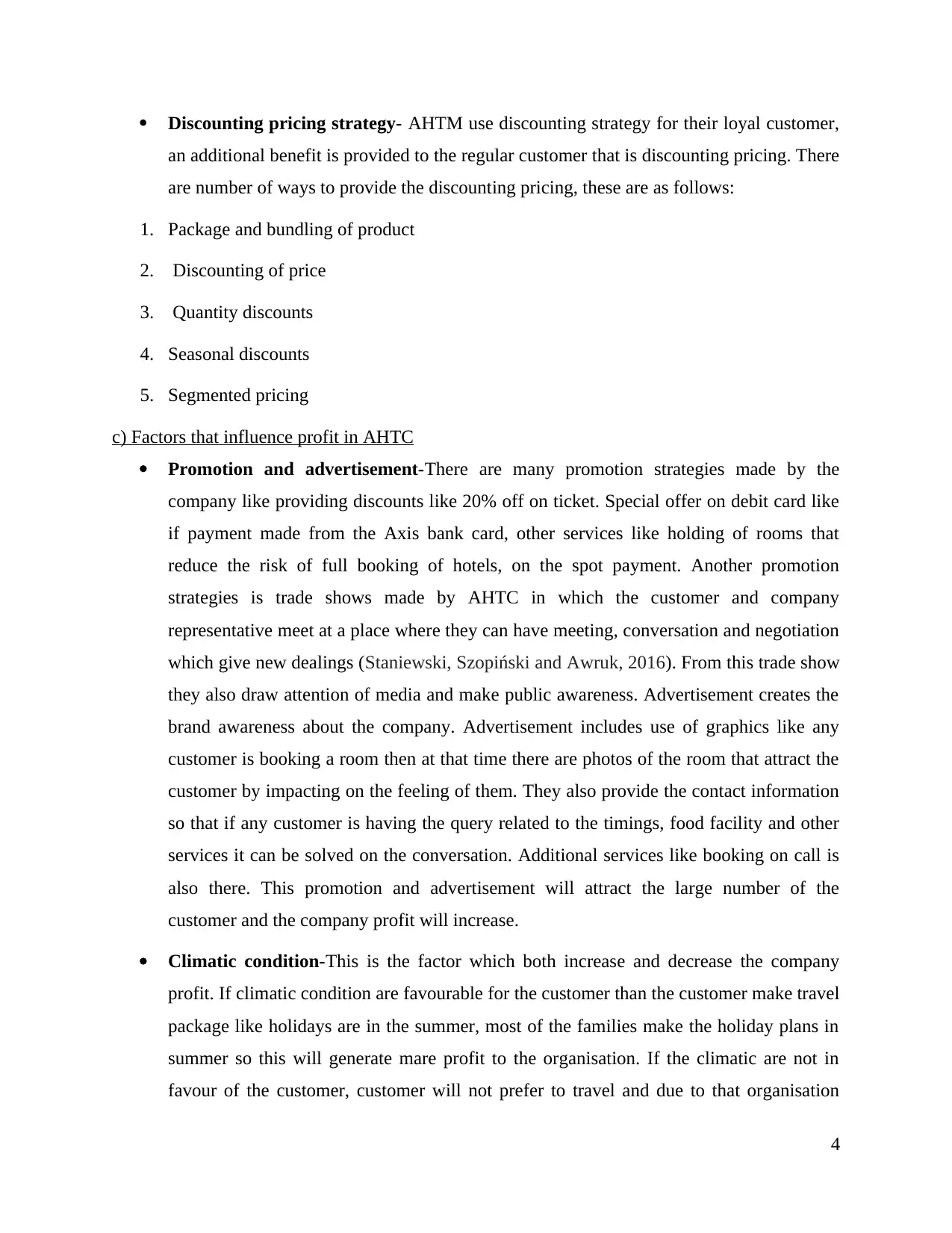
Discounting pricing strategy- AHTM use discounting strategy for their loyal customer,
an additional benefit is provided to the regular customer that is discounting pricing. There
are number of ways to provide the discounting pricing, these are as follows:
1. Package and bundling of product
2. Discounting of price
3. Quantity discounts
4. Seasonal discounts
5. Segmented pricing
c) Factors that influence profit in AHTC
Promotion and advertisement-There are many promotion strategies made by the
company like providing discounts like 20% off on ticket. Special offer on debit card like
if payment made from the Axis bank card, other services like holding of rooms that
reduce the risk of full booking of hotels, on the spot payment. Another promotion
strategies is trade shows made by AHTC in which the customer and company
representative meet at a place where they can have meeting, conversation and negotiation
which give new dealings (Staniewski, Szopiński and Awruk, 2016). From this trade show
they also draw attention of media and make public awareness. Advertisement creates the
brand awareness about the company. Advertisement includes use of graphics like any
customer is booking a room then at that time there are photos of the room that attract the
customer by impacting on the feeling of them. They also provide the contact information
so that if any customer is having the query related to the timings, food facility and other
services it can be solved on the conversation. Additional services like booking on call is
also there. This promotion and advertisement will attract the large number of the
customer and the company profit will increase.
Climatic condition-This is the factor which both increase and decrease the company
profit. If climatic condition are favourable for the customer than the customer make travel
package like holidays are in the summer, most of the families make the holiday plans in
summer so this will generate mare profit to the organisation. If the climatic are not in
favour of the customer, customer will not prefer to travel and due to that organisation
4
an additional benefit is provided to the regular customer that is discounting pricing. There
are number of ways to provide the discounting pricing, these are as follows:
1. Package and bundling of product
2. Discounting of price
3. Quantity discounts
4. Seasonal discounts
5. Segmented pricing
c) Factors that influence profit in AHTC
Promotion and advertisement-There are many promotion strategies made by the
company like providing discounts like 20% off on ticket. Special offer on debit card like
if payment made from the Axis bank card, other services like holding of rooms that
reduce the risk of full booking of hotels, on the spot payment. Another promotion
strategies is trade shows made by AHTC in which the customer and company
representative meet at a place where they can have meeting, conversation and negotiation
which give new dealings (Staniewski, Szopiński and Awruk, 2016). From this trade show
they also draw attention of media and make public awareness. Advertisement creates the
brand awareness about the company. Advertisement includes use of graphics like any
customer is booking a room then at that time there are photos of the room that attract the
customer by impacting on the feeling of them. They also provide the contact information
so that if any customer is having the query related to the timings, food facility and other
services it can be solved on the conversation. Additional services like booking on call is
also there. This promotion and advertisement will attract the large number of the
customer and the company profit will increase.
Climatic condition-This is the factor which both increase and decrease the company
profit. If climatic condition are favourable for the customer than the customer make travel
package like holidays are in the summer, most of the families make the holiday plans in
summer so this will generate mare profit to the organisation. If the climatic are not in
favour of the customer, customer will not prefer to travel and due to that organisation
4
Paraphrase This Document
Need a fresh take? Get an instant paraphrase of this document with our AI Paraphraser
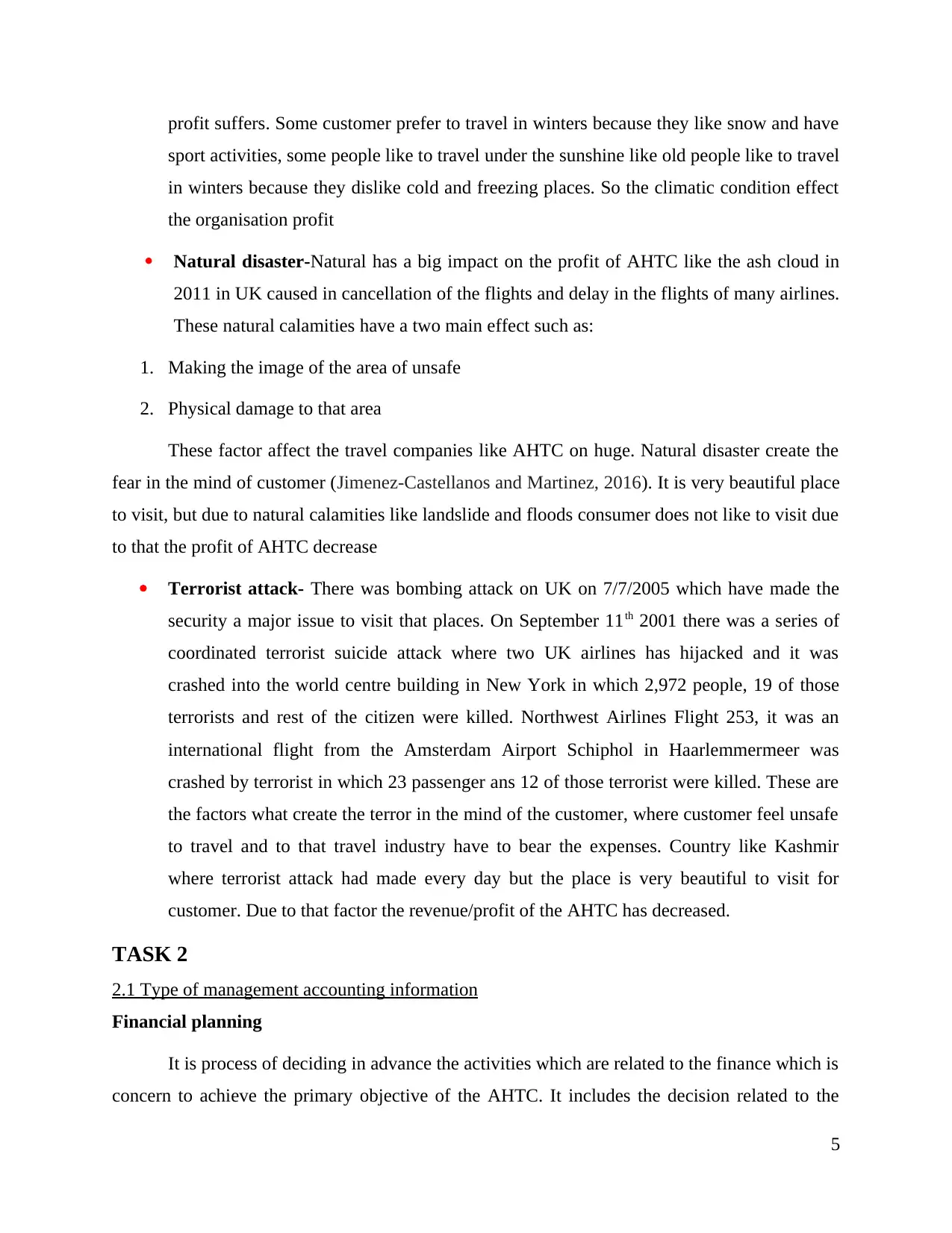
profit suffers. Some customer prefer to travel in winters because they like snow and have
sport activities, some people like to travel under the sunshine like old people like to travel
in winters because they dislike cold and freezing places. So the climatic condition effect
the organisation profit
Natural disaster-Natural has a big impact on the profit of AHTC like the ash cloud in
2011 in UK caused in cancellation of the flights and delay in the flights of many airlines.
These natural calamities have a two main effect such as:
1. Making the image of the area of unsafe
2. Physical damage to that area
These factor affect the travel companies like AHTC on huge. Natural disaster create the
fear in the mind of customer (Jimenez-Castellanos and Martinez, 2016). It is very beautiful place
to visit, but due to natural calamities like landslide and floods consumer does not like to visit due
to that the profit of AHTC decrease
Terrorist attack- There was bombing attack on UK on 7/7/2005 which have made the
security a major issue to visit that places. On September 11th 2001 there was a series of
coordinated terrorist suicide attack where two UK airlines has hijacked and it was
crashed into the world centre building in New York in which 2,972 people, 19 of those
terrorists and rest of the citizen were killed. Northwest Airlines Flight 253, it was an
international flight from the Amsterdam Airport Schiphol in Haarlemmermeer was
crashed by terrorist in which 23 passenger ans 12 of those terrorist were killed. These are
the factors what create the terror in the mind of the customer, where customer feel unsafe
to travel and to that travel industry have to bear the expenses. Country like Kashmir
where terrorist attack had made every day but the place is very beautiful to visit for
customer. Due to that factor the revenue/profit of the AHTC has decreased.
TASK 2
2.1 Type of management accounting information
Financial planning
It is process of deciding in advance the activities which are related to the finance which is
concern to achieve the primary objective of the AHTC. It includes the decision related to the
5
sport activities, some people like to travel under the sunshine like old people like to travel
in winters because they dislike cold and freezing places. So the climatic condition effect
the organisation profit
Natural disaster-Natural has a big impact on the profit of AHTC like the ash cloud in
2011 in UK caused in cancellation of the flights and delay in the flights of many airlines.
These natural calamities have a two main effect such as:
1. Making the image of the area of unsafe
2. Physical damage to that area
These factor affect the travel companies like AHTC on huge. Natural disaster create the
fear in the mind of customer (Jimenez-Castellanos and Martinez, 2016). It is very beautiful place
to visit, but due to natural calamities like landslide and floods consumer does not like to visit due
to that the profit of AHTC decrease
Terrorist attack- There was bombing attack on UK on 7/7/2005 which have made the
security a major issue to visit that places. On September 11th 2001 there was a series of
coordinated terrorist suicide attack where two UK airlines has hijacked and it was
crashed into the world centre building in New York in which 2,972 people, 19 of those
terrorists and rest of the citizen were killed. Northwest Airlines Flight 253, it was an
international flight from the Amsterdam Airport Schiphol in Haarlemmermeer was
crashed by terrorist in which 23 passenger ans 12 of those terrorist were killed. These are
the factors what create the terror in the mind of the customer, where customer feel unsafe
to travel and to that travel industry have to bear the expenses. Country like Kashmir
where terrorist attack had made every day but the place is very beautiful to visit for
customer. Due to that factor the revenue/profit of the AHTC has decreased.
TASK 2
2.1 Type of management accounting information
Financial planning
It is process of deciding in advance the activities which are related to the finance which is
concern to achieve the primary objective of the AHTC. It includes the decision related to the
5
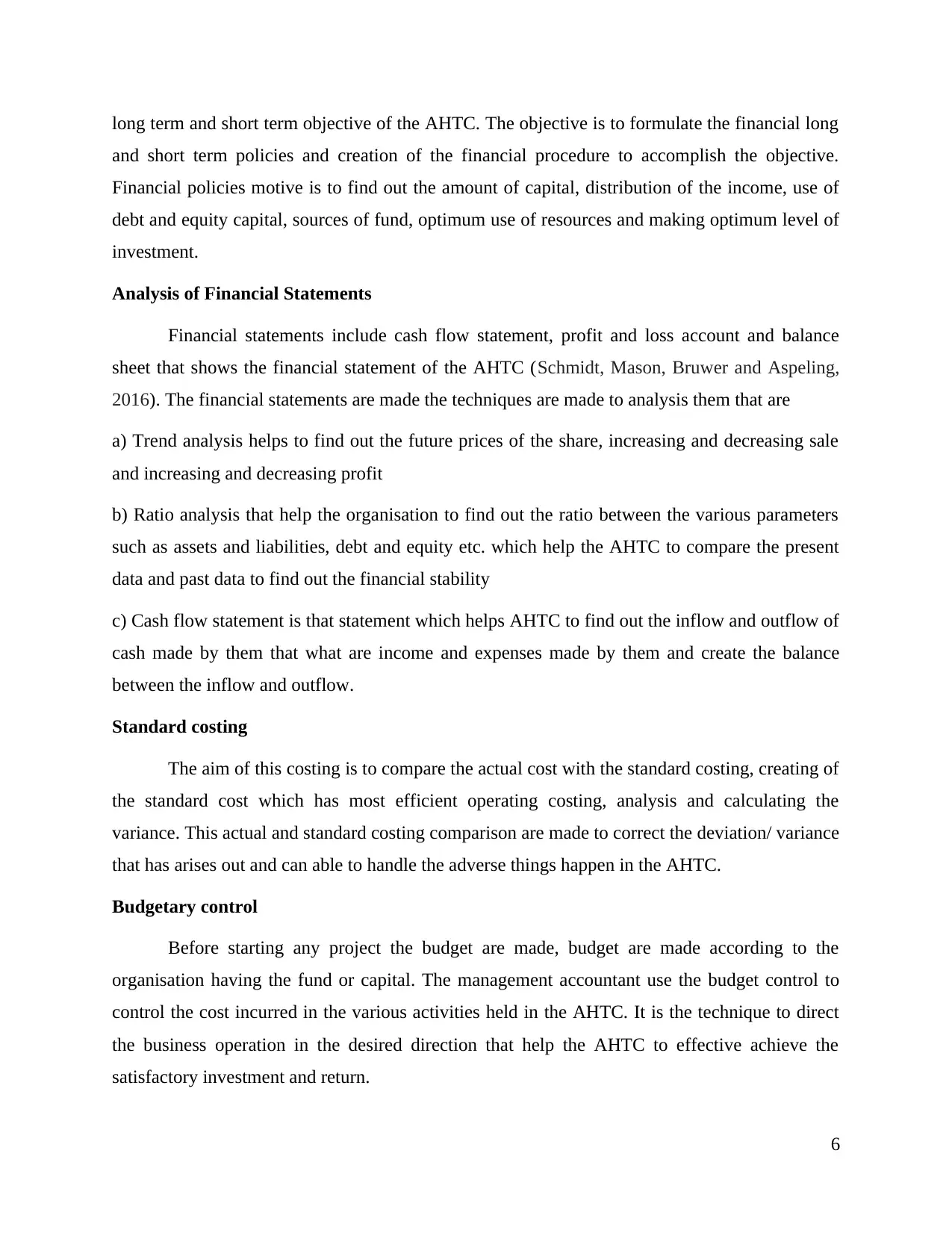
long term and short term objective of the AHTC. The objective is to formulate the financial long
and short term policies and creation of the financial procedure to accomplish the objective.
Financial policies motive is to find out the amount of capital, distribution of the income, use of
debt and equity capital, sources of fund, optimum use of resources and making optimum level of
investment.
Analysis of Financial Statements
Financial statements include cash flow statement, profit and loss account and balance
sheet that shows the financial statement of the AHTC (Schmidt, Mason, Bruwer and Aspeling,
2016). The financial statements are made the techniques are made to analysis them that are
a) Trend analysis helps to find out the future prices of the share, increasing and decreasing sale
and increasing and decreasing profit
b) Ratio analysis that help the organisation to find out the ratio between the various parameters
such as assets and liabilities, debt and equity etc. which help the AHTC to compare the present
data and past data to find out the financial stability
c) Cash flow statement is that statement which helps AHTC to find out the inflow and outflow of
cash made by them that what are income and expenses made by them and create the balance
between the inflow and outflow.
Standard costing
The aim of this costing is to compare the actual cost with the standard costing, creating of
the standard cost which has most efficient operating costing, analysis and calculating the
variance. This actual and standard costing comparison are made to correct the deviation/ variance
that has arises out and can able to handle the adverse things happen in the AHTC.
Budgetary control
Before starting any project the budget are made, budget are made according to the
organisation having the fund or capital. The management accountant use the budget control to
control the cost incurred in the various activities held in the AHTC. It is the technique to direct
the business operation in the desired direction that help the AHTC to effective achieve the
satisfactory investment and return.
6
and short term policies and creation of the financial procedure to accomplish the objective.
Financial policies motive is to find out the amount of capital, distribution of the income, use of
debt and equity capital, sources of fund, optimum use of resources and making optimum level of
investment.
Analysis of Financial Statements
Financial statements include cash flow statement, profit and loss account and balance
sheet that shows the financial statement of the AHTC (Schmidt, Mason, Bruwer and Aspeling,
2016). The financial statements are made the techniques are made to analysis them that are
a) Trend analysis helps to find out the future prices of the share, increasing and decreasing sale
and increasing and decreasing profit
b) Ratio analysis that help the organisation to find out the ratio between the various parameters
such as assets and liabilities, debt and equity etc. which help the AHTC to compare the present
data and past data to find out the financial stability
c) Cash flow statement is that statement which helps AHTC to find out the inflow and outflow of
cash made by them that what are income and expenses made by them and create the balance
between the inflow and outflow.
Standard costing
The aim of this costing is to compare the actual cost with the standard costing, creating of
the standard cost which has most efficient operating costing, analysis and calculating the
variance. This actual and standard costing comparison are made to correct the deviation/ variance
that has arises out and can able to handle the adverse things happen in the AHTC.
Budgetary control
Before starting any project the budget are made, budget are made according to the
organisation having the fund or capital. The management accountant use the budget control to
control the cost incurred in the various activities held in the AHTC. It is the technique to direct
the business operation in the desired direction that help the AHTC to effective achieve the
satisfactory investment and return.
6
⊘ This is a preview!⊘
Do you want full access?
Subscribe today to unlock all pages.

Trusted by 1+ million students worldwide
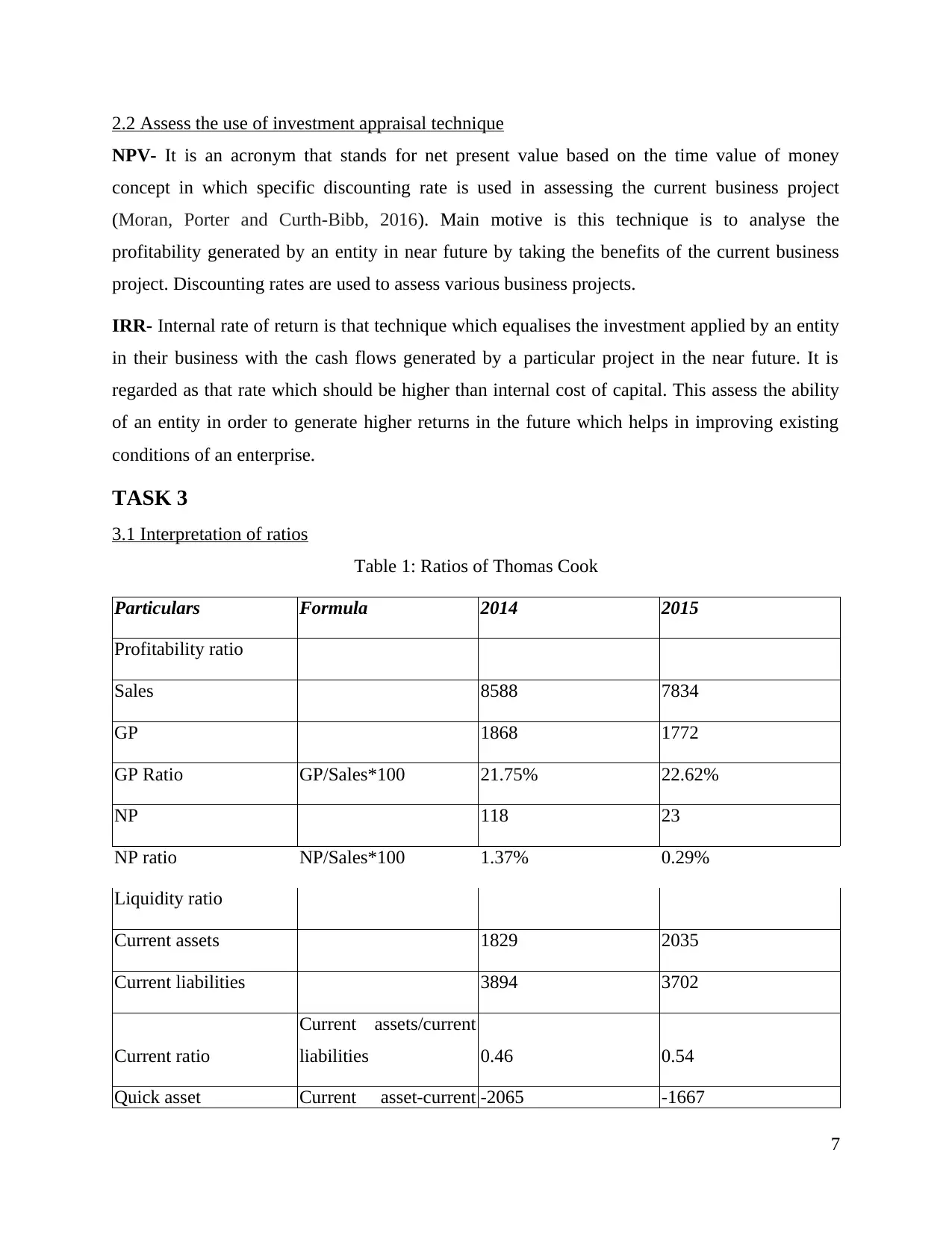
2.2 Assess the use of investment appraisal technique
NPV- It is an acronym that stands for net present value based on the time value of money
concept in which specific discounting rate is used in assessing the current business project
(Moran, Porter and Curth‐Bibb, 2016). Main motive is this technique is to analyse the
profitability generated by an entity in near future by taking the benefits of the current business
project. Discounting rates are used to assess various business projects.
IRR- Internal rate of return is that technique which equalises the investment applied by an entity
in their business with the cash flows generated by a particular project in the near future. It is
regarded as that rate which should be higher than internal cost of capital. This assess the ability
of an entity in order to generate higher returns in the future which helps in improving existing
conditions of an enterprise.
TASK 3
3.1 Interpretation of ratios
Table 1: Ratios of Thomas Cook
Particulars Formula 2014 2015
Profitability ratio
Sales 8588 7834
GP 1868 1772
GP Ratio GP/Sales*100 21.75% 22.62%
NP 118 23
NP ratio NP/Sales*100 1.37% 0.29%
Liquidity ratio
Current assets 1829 2035
Current liabilities 3894 3702
Current ratio
Current assets/current
liabilities 0.46 0.54
Quick asset Current asset-current -2065 -1667
7
NPV- It is an acronym that stands for net present value based on the time value of money
concept in which specific discounting rate is used in assessing the current business project
(Moran, Porter and Curth‐Bibb, 2016). Main motive is this technique is to analyse the
profitability generated by an entity in near future by taking the benefits of the current business
project. Discounting rates are used to assess various business projects.
IRR- Internal rate of return is that technique which equalises the investment applied by an entity
in their business with the cash flows generated by a particular project in the near future. It is
regarded as that rate which should be higher than internal cost of capital. This assess the ability
of an entity in order to generate higher returns in the future which helps in improving existing
conditions of an enterprise.
TASK 3
3.1 Interpretation of ratios
Table 1: Ratios of Thomas Cook
Particulars Formula 2014 2015
Profitability ratio
Sales 8588 7834
GP 1868 1772
GP Ratio GP/Sales*100 21.75% 22.62%
NP 118 23
NP ratio NP/Sales*100 1.37% 0.29%
Liquidity ratio
Current assets 1829 2035
Current liabilities 3894 3702
Current ratio
Current assets/current
liabilities 0.46 0.54
Quick asset Current asset-current -2065 -1667
7
Paraphrase This Document
Need a fresh take? Get an instant paraphrase of this document with our AI Paraphraser
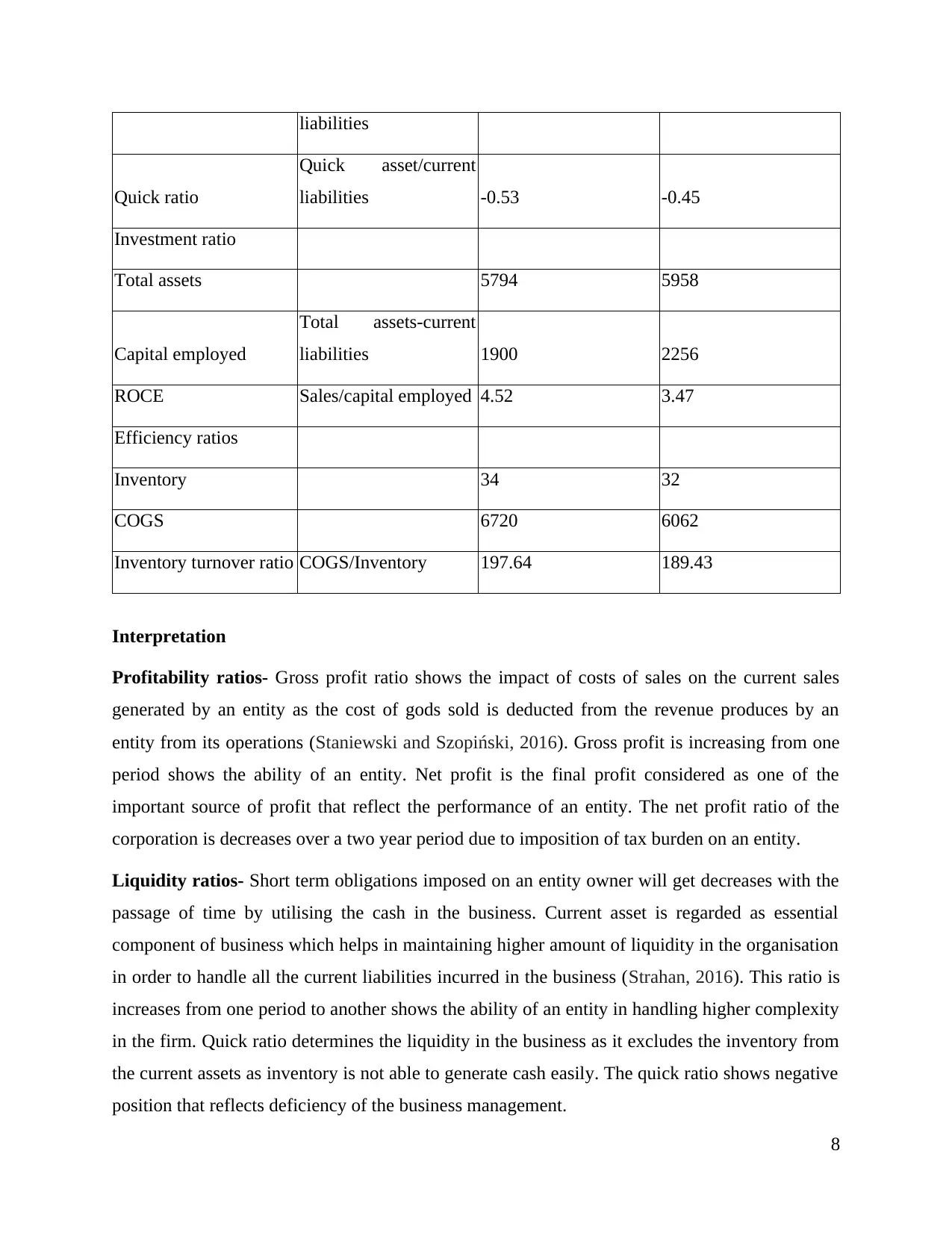
liabilities
Quick ratio
Quick asset/current
liabilities -0.53 -0.45
Investment ratio
Total assets 5794 5958
Capital employed
Total assets-current
liabilities 1900 2256
ROCE Sales/capital employed 4.52 3.47
Efficiency ratios
Inventory 34 32
COGS 6720 6062
Inventory turnover ratio COGS/Inventory 197.64 189.43
Interpretation
Profitability ratios- Gross profit ratio shows the impact of costs of sales on the current sales
generated by an entity as the cost of gods sold is deducted from the revenue produces by an
entity from its operations (Staniewski and Szopiński, 2016). Gross profit is increasing from one
period shows the ability of an entity. Net profit is the final profit considered as one of the
important source of profit that reflect the performance of an entity. The net profit ratio of the
corporation is decreases over a two year period due to imposition of tax burden on an entity.
Liquidity ratios- Short term obligations imposed on an entity owner will get decreases with the
passage of time by utilising the cash in the business. Current asset is regarded as essential
component of business which helps in maintaining higher amount of liquidity in the organisation
in order to handle all the current liabilities incurred in the business (Strahan, 2016). This ratio is
increases from one period to another shows the ability of an entity in handling higher complexity
in the firm. Quick ratio determines the liquidity in the business as it excludes the inventory from
the current assets as inventory is not able to generate cash easily. The quick ratio shows negative
position that reflects deficiency of the business management.
8
Quick ratio
Quick asset/current
liabilities -0.53 -0.45
Investment ratio
Total assets 5794 5958
Capital employed
Total assets-current
liabilities 1900 2256
ROCE Sales/capital employed 4.52 3.47
Efficiency ratios
Inventory 34 32
COGS 6720 6062
Inventory turnover ratio COGS/Inventory 197.64 189.43
Interpretation
Profitability ratios- Gross profit ratio shows the impact of costs of sales on the current sales
generated by an entity as the cost of gods sold is deducted from the revenue produces by an
entity from its operations (Staniewski and Szopiński, 2016). Gross profit is increasing from one
period shows the ability of an entity. Net profit is the final profit considered as one of the
important source of profit that reflect the performance of an entity. The net profit ratio of the
corporation is decreases over a two year period due to imposition of tax burden on an entity.
Liquidity ratios- Short term obligations imposed on an entity owner will get decreases with the
passage of time by utilising the cash in the business. Current asset is regarded as essential
component of business which helps in maintaining higher amount of liquidity in the organisation
in order to handle all the current liabilities incurred in the business (Strahan, 2016). This ratio is
increases from one period to another shows the ability of an entity in handling higher complexity
in the firm. Quick ratio determines the liquidity in the business as it excludes the inventory from
the current assets as inventory is not able to generate cash easily. The quick ratio shows negative
position that reflects deficiency of the business management.
8
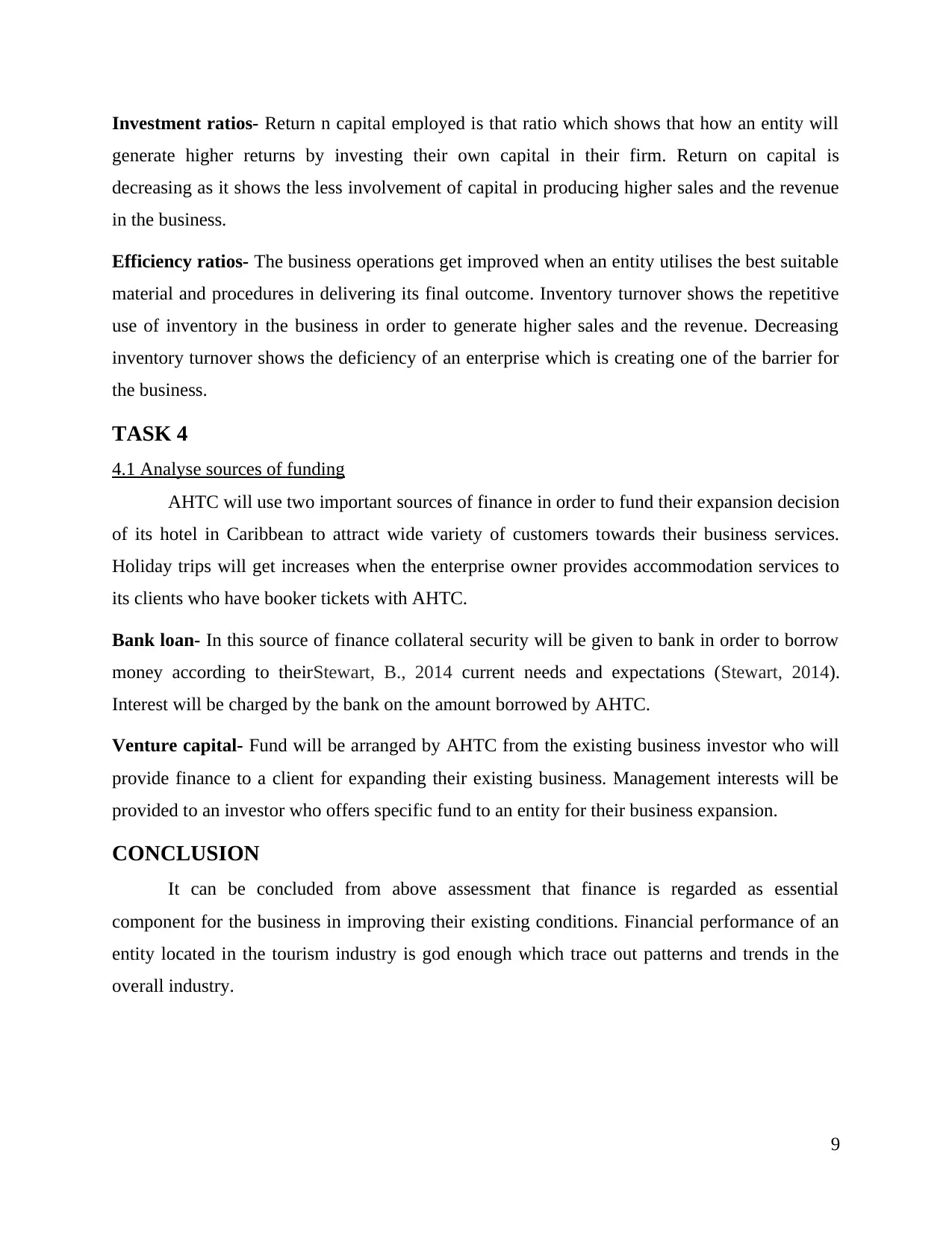
Investment ratios- Return n capital employed is that ratio which shows that how an entity will
generate higher returns by investing their own capital in their firm. Return on capital is
decreasing as it shows the less involvement of capital in producing higher sales and the revenue
in the business.
Efficiency ratios- The business operations get improved when an entity utilises the best suitable
material and procedures in delivering its final outcome. Inventory turnover shows the repetitive
use of inventory in the business in order to generate higher sales and the revenue. Decreasing
inventory turnover shows the deficiency of an enterprise which is creating one of the barrier for
the business.
TASK 4
4.1 Analyse sources of funding
AHTC will use two important sources of finance in order to fund their expansion decision
of its hotel in Caribbean to attract wide variety of customers towards their business services.
Holiday trips will get increases when the enterprise owner provides accommodation services to
its clients who have booker tickets with AHTC.
Bank loan- In this source of finance collateral security will be given to bank in order to borrow
money according to theirStewart, B., 2014 current needs and expectations (Stewart, 2014).
Interest will be charged by the bank on the amount borrowed by AHTC.
Venture capital- Fund will be arranged by AHTC from the existing business investor who will
provide finance to a client for expanding their existing business. Management interests will be
provided to an investor who offers specific fund to an entity for their business expansion.
CONCLUSION
It can be concluded from above assessment that finance is regarded as essential
component for the business in improving their existing conditions. Financial performance of an
entity located in the tourism industry is god enough which trace out patterns and trends in the
overall industry.
9
generate higher returns by investing their own capital in their firm. Return on capital is
decreasing as it shows the less involvement of capital in producing higher sales and the revenue
in the business.
Efficiency ratios- The business operations get improved when an entity utilises the best suitable
material and procedures in delivering its final outcome. Inventory turnover shows the repetitive
use of inventory in the business in order to generate higher sales and the revenue. Decreasing
inventory turnover shows the deficiency of an enterprise which is creating one of the barrier for
the business.
TASK 4
4.1 Analyse sources of funding
AHTC will use two important sources of finance in order to fund their expansion decision
of its hotel in Caribbean to attract wide variety of customers towards their business services.
Holiday trips will get increases when the enterprise owner provides accommodation services to
its clients who have booker tickets with AHTC.
Bank loan- In this source of finance collateral security will be given to bank in order to borrow
money according to theirStewart, B., 2014 current needs and expectations (Stewart, 2014).
Interest will be charged by the bank on the amount borrowed by AHTC.
Venture capital- Fund will be arranged by AHTC from the existing business investor who will
provide finance to a client for expanding their existing business. Management interests will be
provided to an investor who offers specific fund to an entity for their business expansion.
CONCLUSION
It can be concluded from above assessment that finance is regarded as essential
component for the business in improving their existing conditions. Financial performance of an
entity located in the tourism industry is god enough which trace out patterns and trends in the
overall industry.
9
⊘ This is a preview!⊘
Do you want full access?
Subscribe today to unlock all pages.

Trusted by 1+ million students worldwide
1 out of 13
Related Documents
Your All-in-One AI-Powered Toolkit for Academic Success.
+13062052269
info@desklib.com
Available 24*7 on WhatsApp / Email
![[object Object]](/_next/static/media/star-bottom.7253800d.svg)
Unlock your academic potential
Copyright © 2020–2025 A2Z Services. All Rights Reserved. Developed and managed by ZUCOL.





